Negiyaki is a fluffy and light Japanese savory pancake packed with refreshing and crunchy green onions and brushed with fragrant soy sauce or okonomiyaki sauce. This grilled Osaka specialty makes a delicious appetizer or main dish!
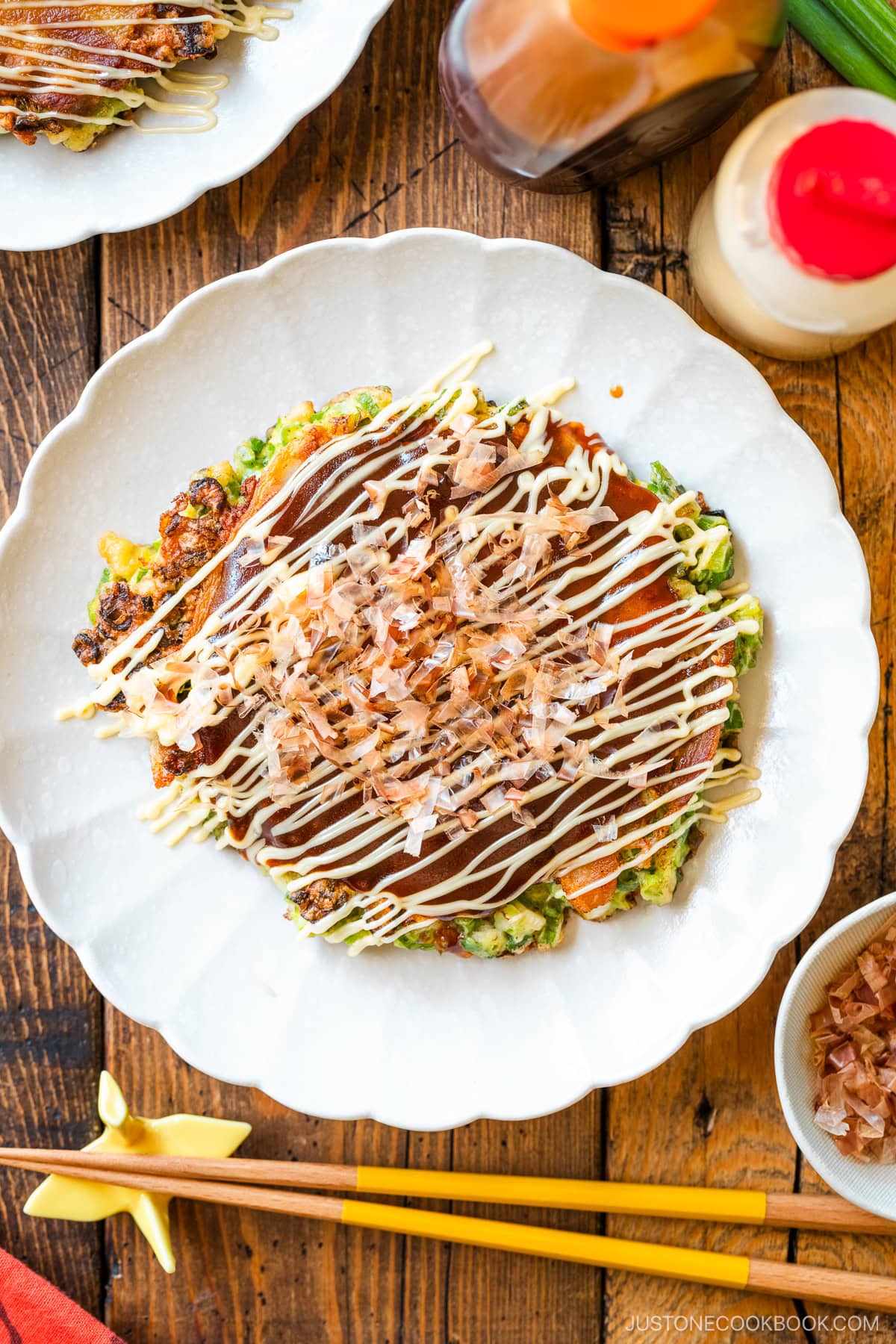
Let me introduce you to an aromatic and refreshing Japanese scallion pancake called Negiyaki. This Osaka specialty is my husband’s favorite savory pancake, so I was excited to discover how easy it is to make at home in a frying pan. I’ll share the tips that I learned from my best friend Yukako in Osaka for how to keep the negiyaki crisp, light, and fluffy!
If you’re craving more savory pancake recipes, try my Okonomiyaki, Hiroshima-Style Okonomiyaki, and Korean Pancake (Pajeon) next!
What is Negiyaki?
Negiyaki (ねぎ焼き) was invented in the 1960s by a widowed mother of seven children who opened the Osaka shop Negiyaki Yamamoto as an okonomiyaki restaurant. She cooked her kids a daily after-school snack of okonomi batter packed with chopped green onions instead of cabbage. Customers wanted to eat it, too, so she added it to the menu. This dish’s signature scallion flavor is now the famed “taste of Osaka.”
Table of Contents
Why I Love This Recipe
- Fast – You can pull together this savory pancake in no time! It takes just about 20–25 minutes from start to finish.
- Easy to prepare – Just mix the batter and cook in a frying pan.
- Refreshing taste – It’s savory and herbaceous, with more green onions than batter.
- Fluffy and light texture – The technique I share makes an airy pancake that keeps the scallions crunchy.
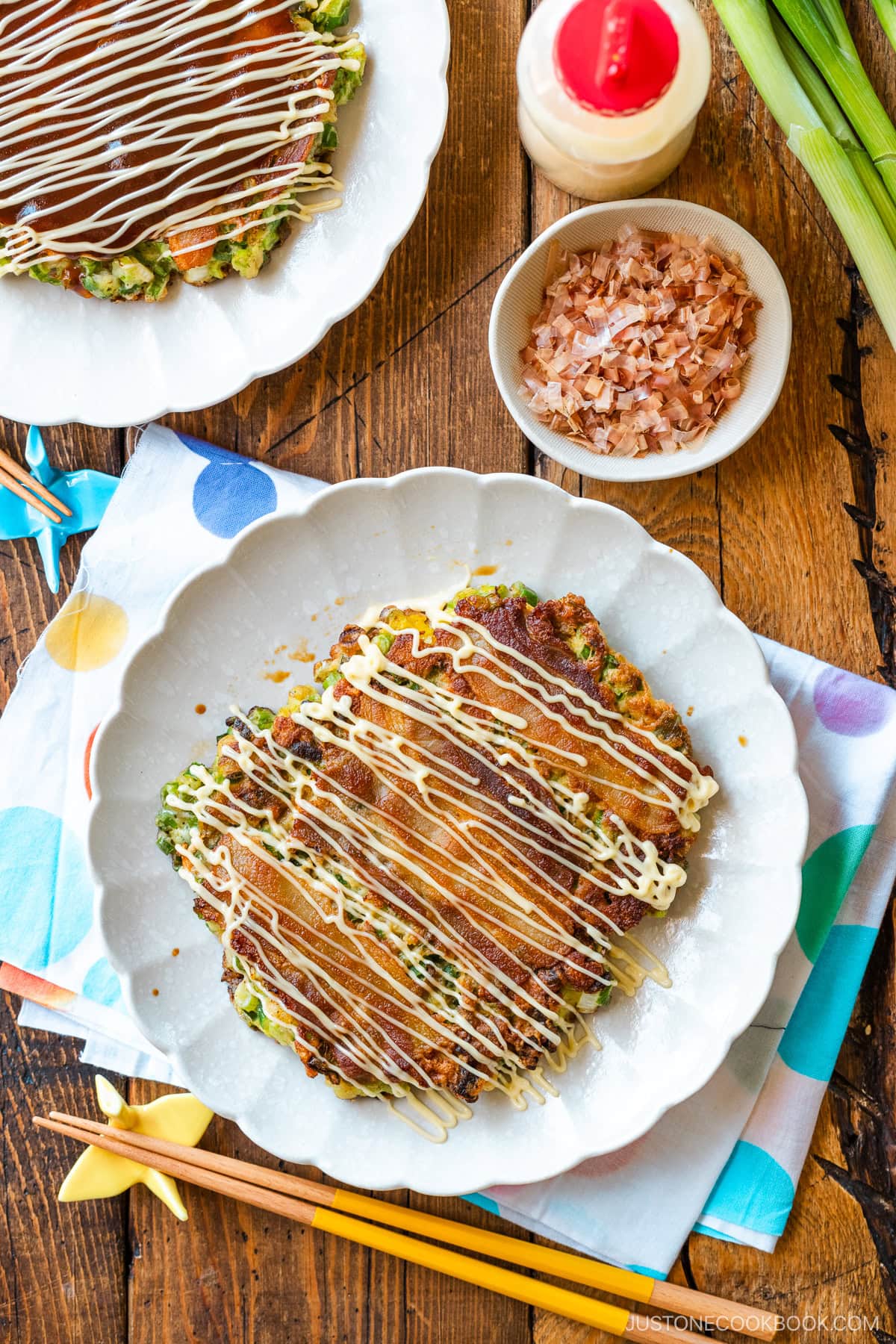
Ingredients for Negiyaki
- Green onions/scallions
- Sliced pork belly
- All-purpose flour
- Baking powder
- Katsuobushi (dried bonito flakes)
- Tenkasu (agedama) (tempura scraps)
- Large eggs
- Soy sauce
- Toppings:
- Soy sauce or okonomi sauce
- Japanese Kewpie mayonnaise – optional
- katsuobushi – optional
Find the printable recipe with measurements below.
Jump to RecipeSubstitutions
- Tenkasu: These tempura scraps add a delicious savory flavor and volume to the pancake. If you can’t find them at the Japanese grocery store, you can make your own tenkasu (after deep-frying tempura) or simply leave them out.
- Soy sauce: Use tamari soy sauce for gluten-free.
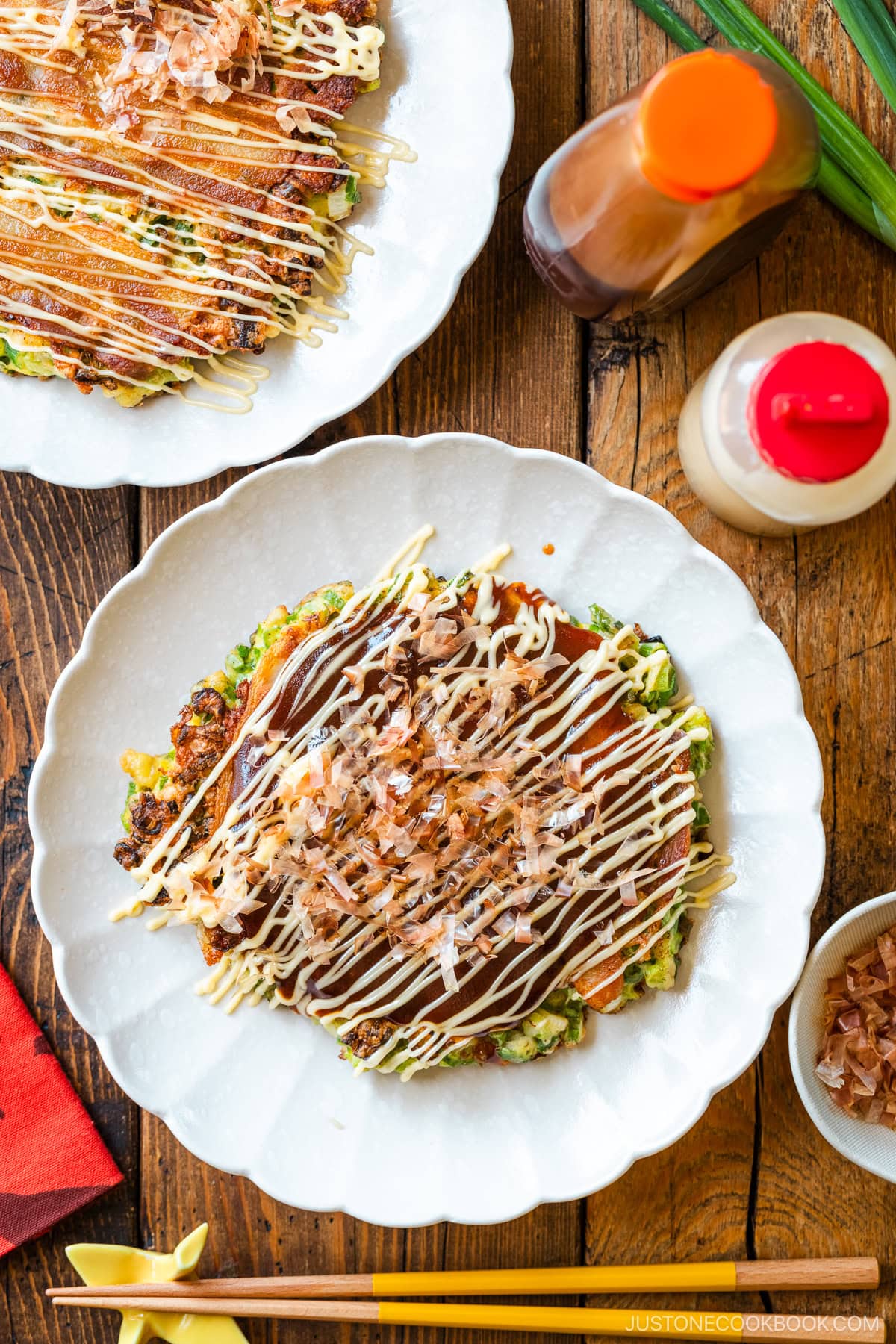
Key Equipment
- two large frying pans or one large griddle to cook all the batter at once
- two spatulas to flip the negiyaki
How to Make Negiyaki
Preparation
Step 1 – Prepare the ingredients. Chop the green onions/scallions and cut the sliced pork belly into short strips. Grind the katsuobushi into a powder.
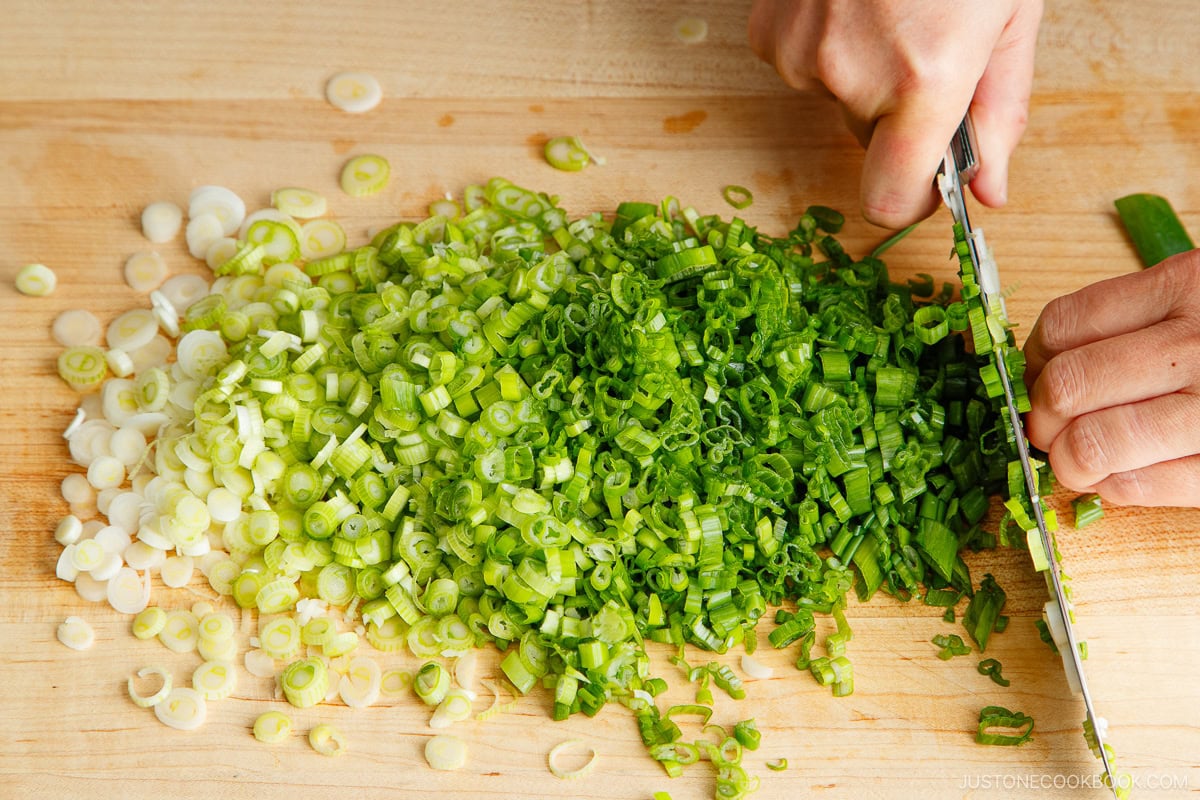
Step 2 – Mix the batter. Toss the chopped green onions in all-purpose flour to coat. Add the baking powder, tempura scraps, katsuobushi powder, eggs, soy sauce, and water. Mix with a spoon until just combined, and do not overmix.
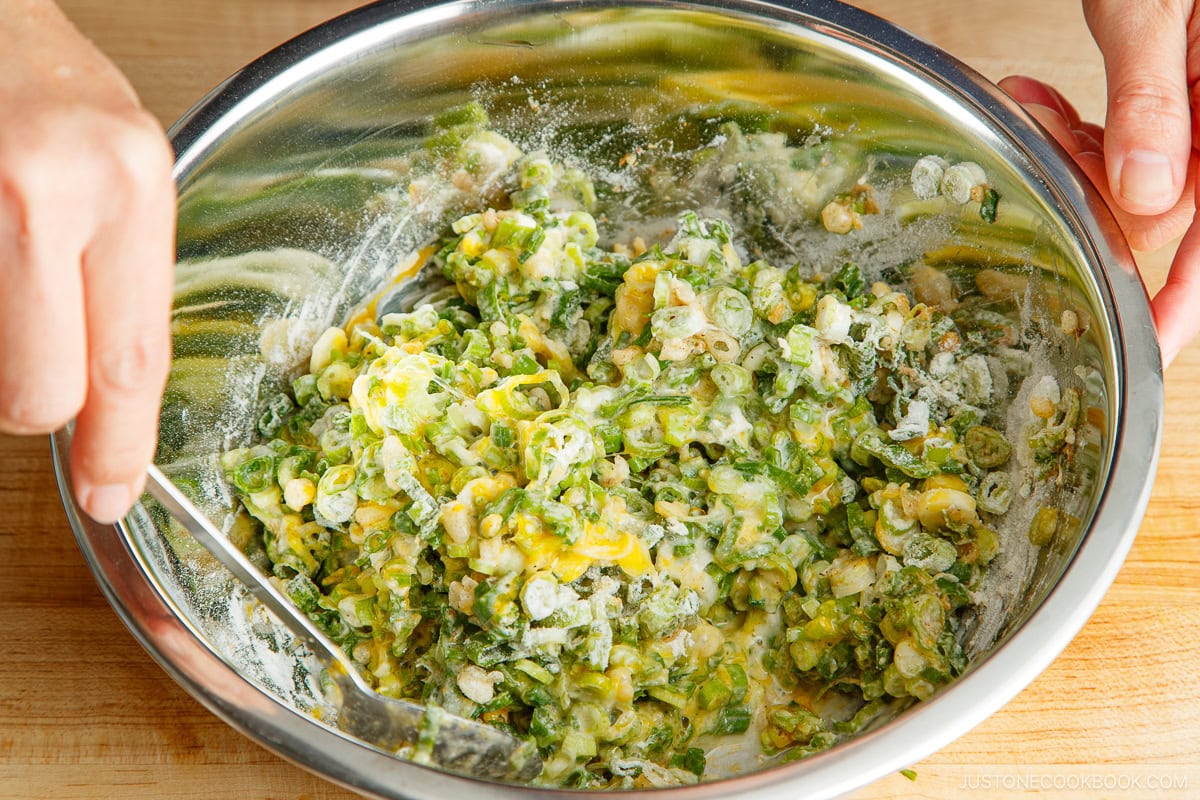
Cooking
Step 3 – Cook all the batter at once. Immediately after mixing, divide the batter in half and use two frying pans to cook the two pancakes at the same time. Sprinkle with katsuobushi powder and spread the pork belly slices across the top.
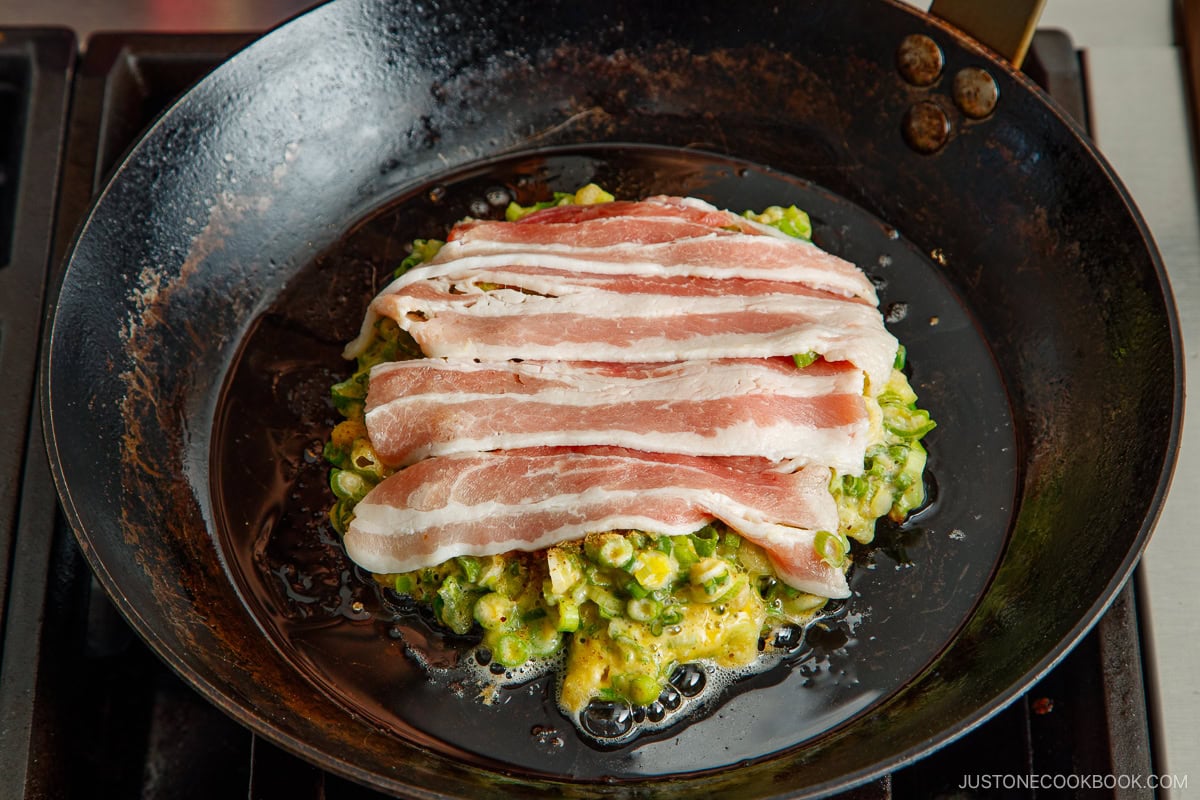
Step 4 – Flip and finish cooking. Using two spatulas, flip the pancakes over. Gently press and fix the round shape. Reduce the heat to low and cook, covered, for 4 minutes. Flip again and cook over medium heat for 1 minute longer.
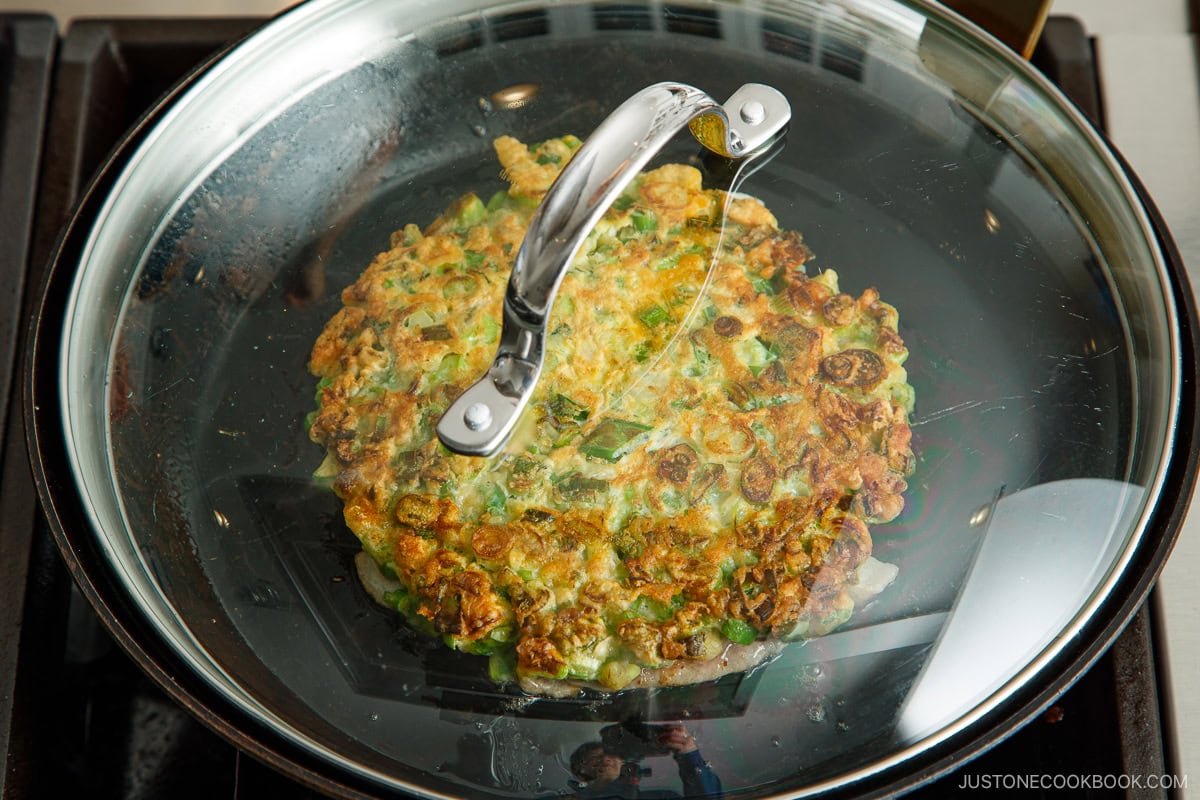
Assemble
Step 5 – Add your favorite toppings and serve. You can brush the top with soy sauce or okonomi sauce, then drizzle with Japanese mayonnaise and sprinkle with dried bonito flakes.
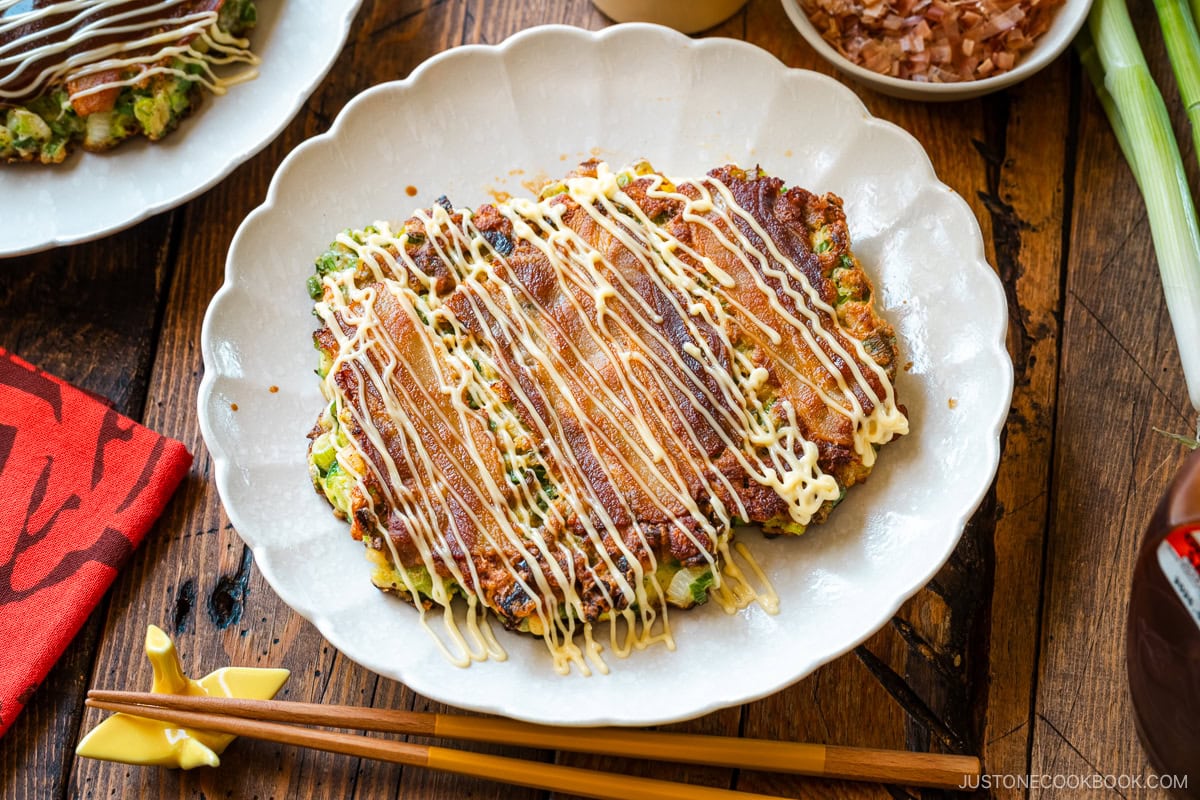
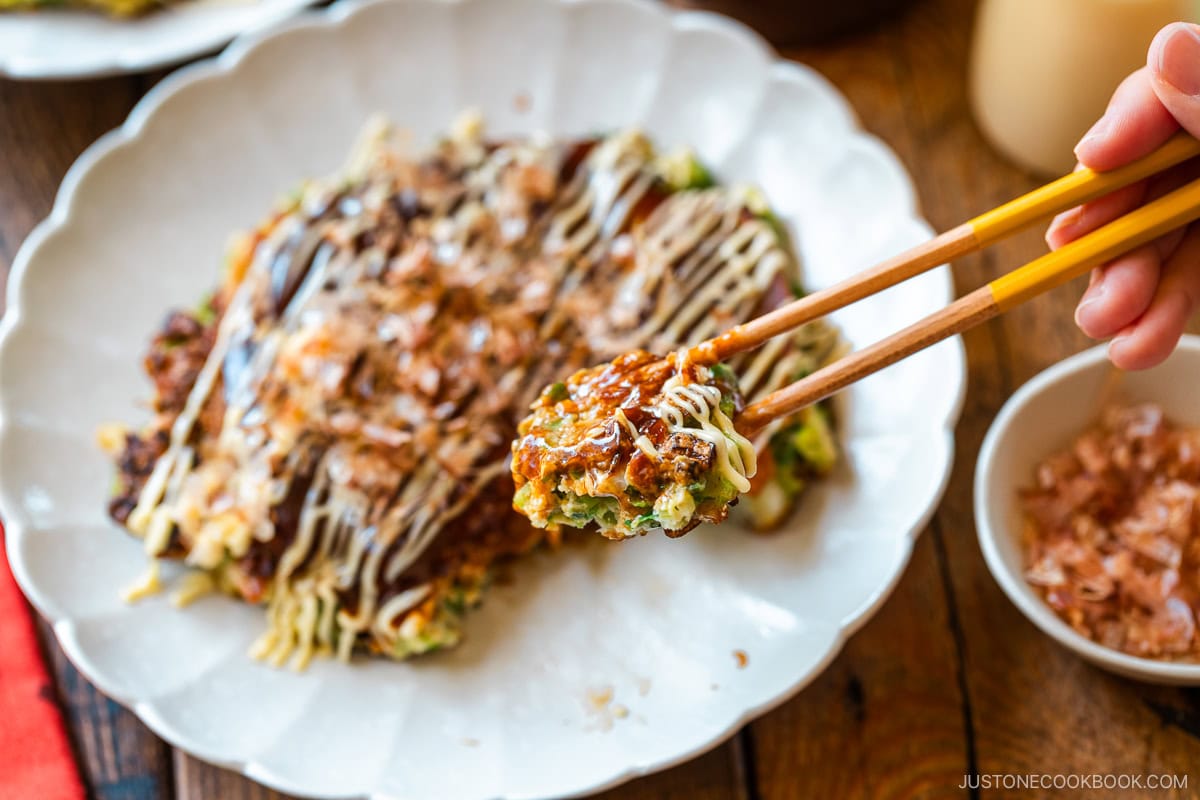
Nami’s Recipe Tips
- Mix the batter until just combined. DO NOT overmix. I suggest a light touch so you don’t crush the green onions or develop the gluten in the flour. This helps keep the pancakes light and fluffy with a fresh green onion crunch.
- Cook immediately after mixing the batter. This keeps the batter airy and the green onions crunchy. I don’t let the batter sit for long. Otherwise, it will go flat and the pancake will be dense.
- Fry at the same time using two pans. Cook all of the batter at the same time using two frying pans or a large griddle. If you have only one frying pan, mix just half the batter and fry one negiyaki, then repeat with the other half.
- Mix and cook only one batch of batter at a time, even if you are doubling or tripling the recipe.
- Use the freshest ingredients you can find. Green onion is the star of the dish, so I choose very fresh scallion stalks with firm, deep green leaves and a white stem end; the leaves should not be wilted. Also, make sure your baking powder is fresh since this is what gives the batter its light and airy texture.
Variations and Customizations
I love the flexibility of this savory negiyaki recipe because it’s so easy to customize:
- Use other proteins. Instead of using pork belly, you can try to recreate the most common negiyaki order called sujinegi (筋ネギ) or sujikon (筋コン) with sweet and spicy simmered wagyu beef tendon and konnyaku (konjac). You can also substitute chopped shrimp or squid.
- Make it meatless. Skip the pork and mix in cheese or cubes of mochi (rice cake). You can also top it with an egg. I spread the batter in the pan, crack an egg on top, then flip the pancake to cook the egg.
- Change the sauce. Try brushing on ponzu sauce for a refreshing twist; mix lemon juice into your soy sauce before brushing to keep it simple. Worcestershire sauce is also a good choice if you like a tangy flavor. To enhance the taste of plain soy sauce, you can pan-grill it; simply brush the pancake with shoyu on both sides and quickly fry it. Mayo not your thing? Feel free to skip it!
- Try other types of green onions/scallions for a slightly different flavor or texture. For example, you can mince both the green and white parts of Tokyo negi (long green onions) for a stronger texture. You could also try spring onions for a more intense flavor.
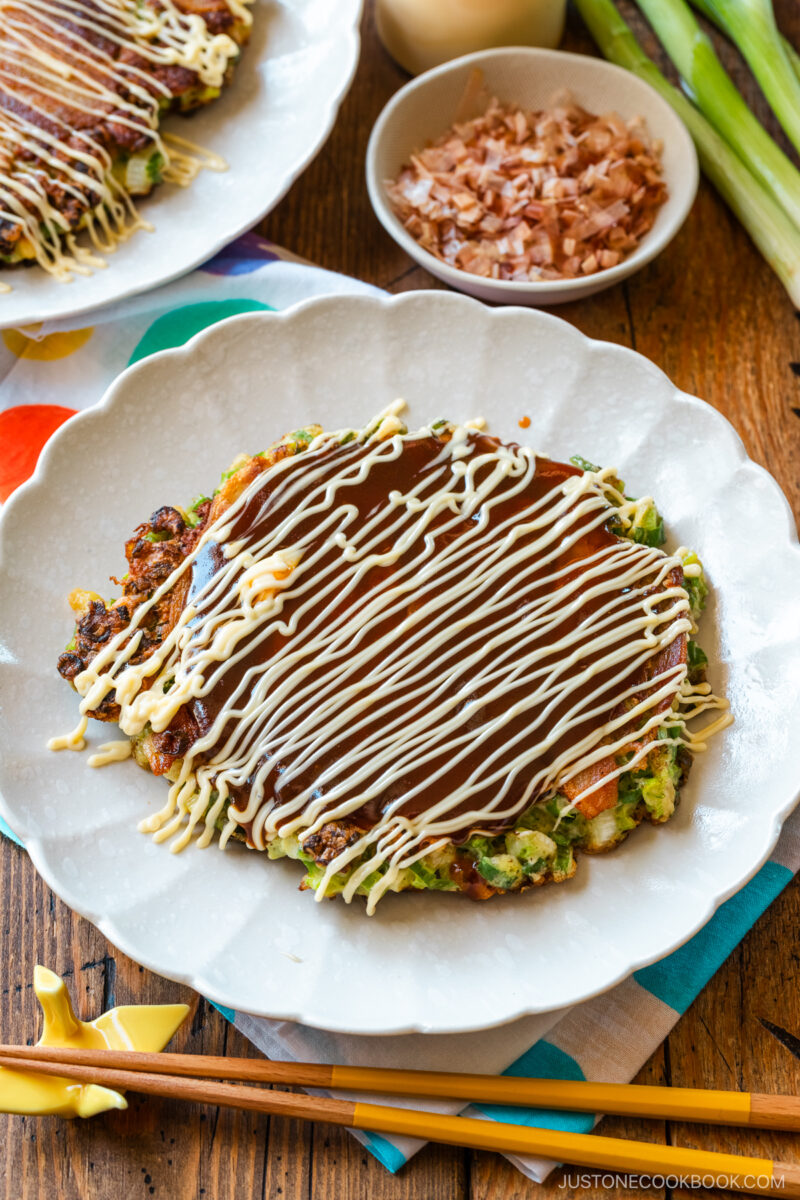
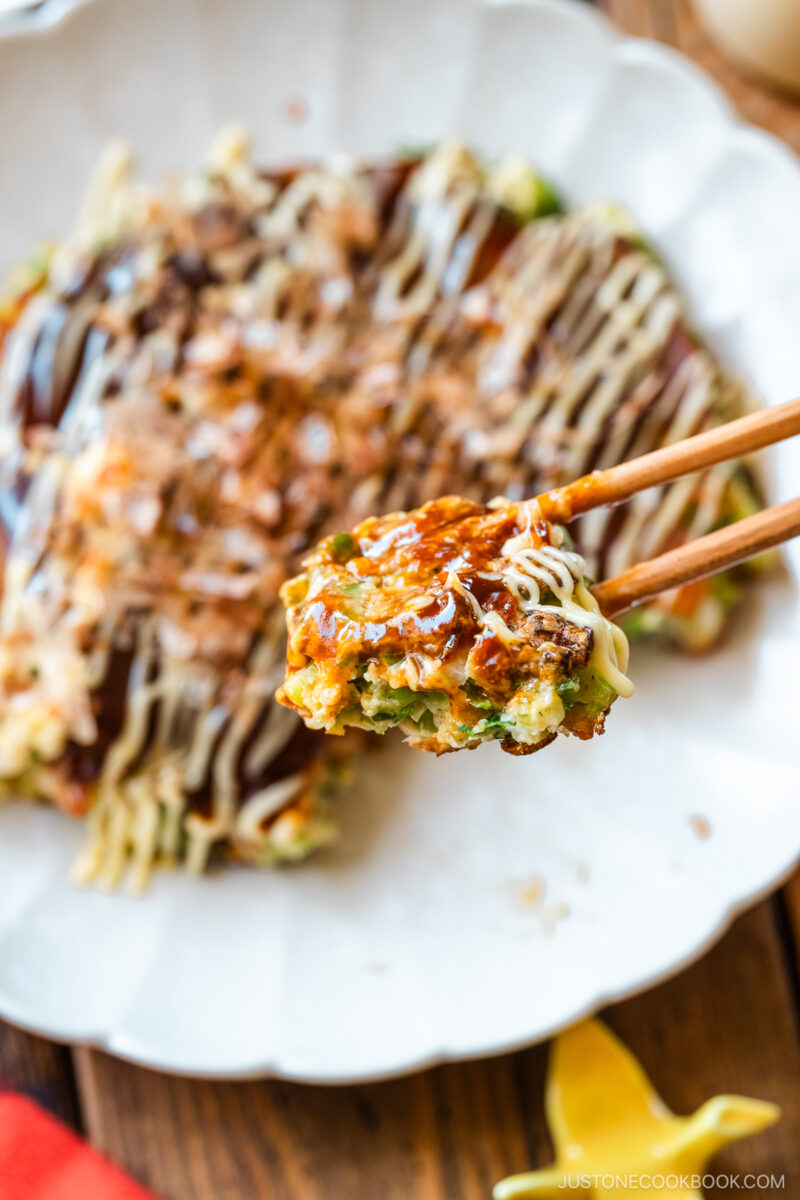
What to Serve with Negiyaki
I enjoy serving negiyaki as an appetizer as it makes a delicious accompaniment to dishes like the ones I suggest below:
- Side: Hiyayakko (Cold Tofu)
- Salad: Harusame Salad
- Main Dish: Japanese Fried Chicken (Karaage)
- Rice or Noodles: Yaki Onigiri (Grilled Rice Ball)
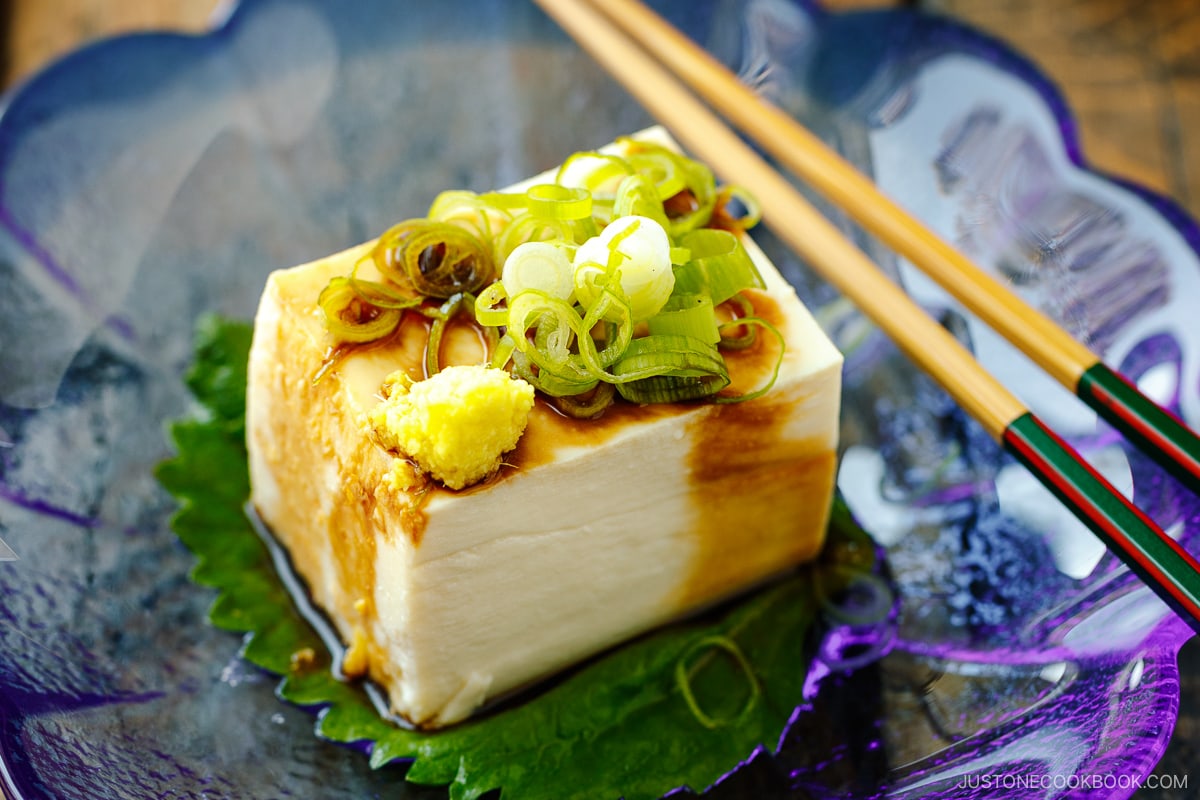
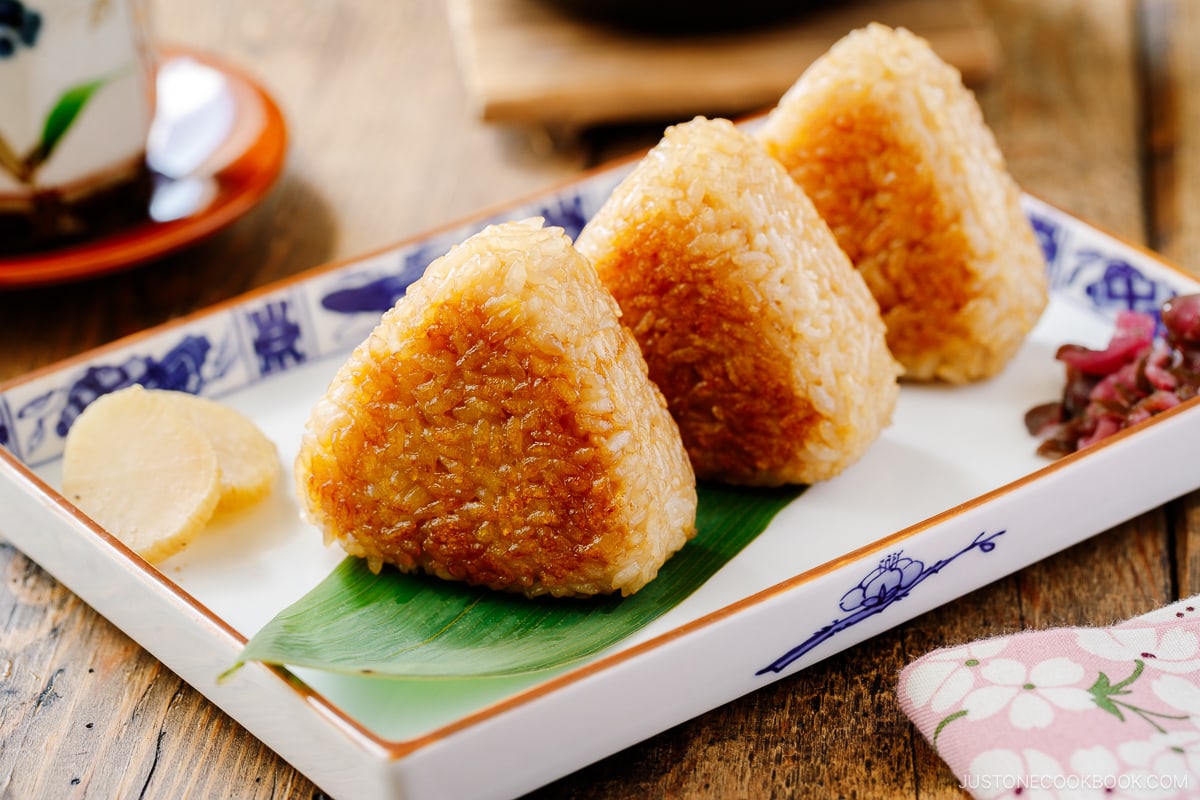
Storage and Reheating Tips
To store: Wrap each leftover negiyaki, without the sauce or toppings, in aluminum foil and place in a freezer bag. Store in the refrigerator for up to 3 days and in the freezer for a month.
To reheat: Heat the refrigerated negiyaki in a toaster oven or regular oven at 350°F (180°C) for 10–15 minutes. If it’s frozen, move it to the fridge to defrost overnight and reheat as above or heat direct from frozen in a 350°F (180°C) oven for 25–30 minutes.
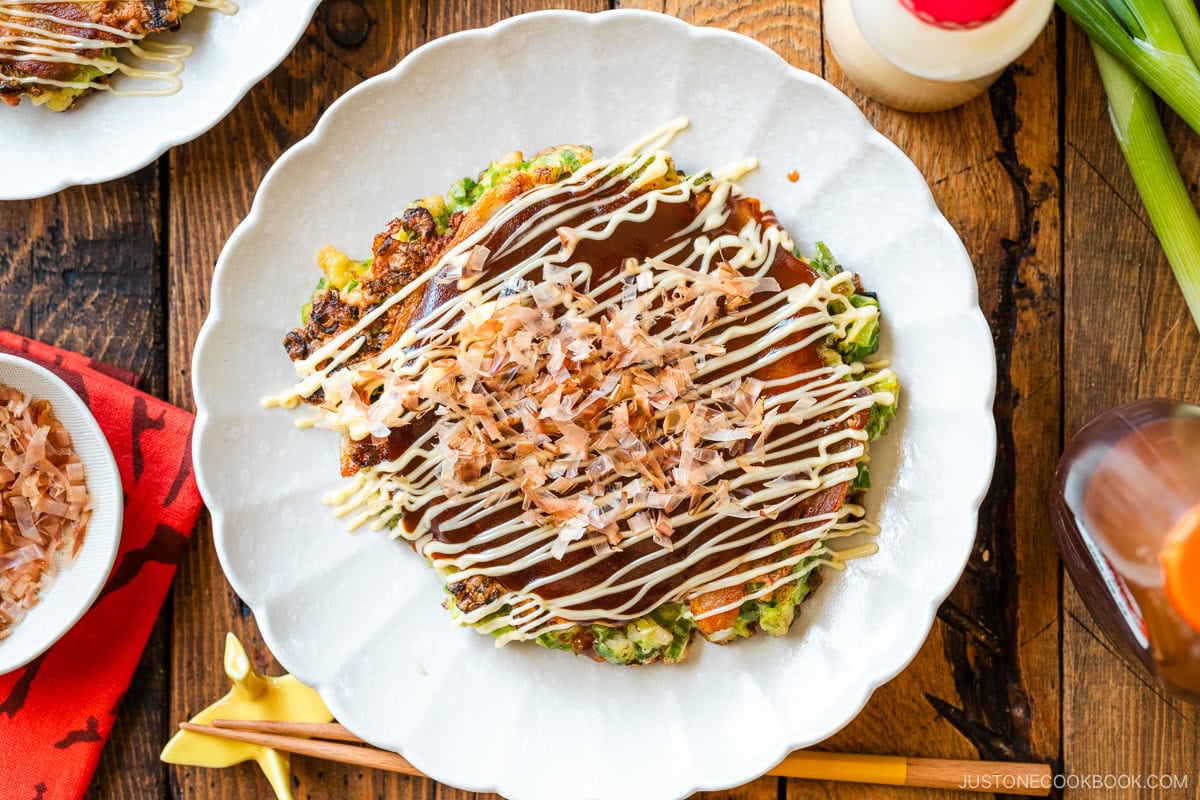
Frequently Asked Questions
You may have overmixed the batter or left it in the bowl too long. Next time, mix the batter ingredients until just barely combined, and cook it as soon as you’re done.
Yes, but you can only mix one batch of batter at a time. If you mix more than that, any batter that you don’t cook immediately will go flat. I suggest mixing just one batch at a time and cooking two pancakes at once in two frying pans or on a large griddle.
Mix just half a batch of the batter and fry one pancake, then repeat with the other half.
More Delicious Scallion Recipes
If you love this negiyaki, you’re in for a treat with these other irresistible recipes featuring green onions.
- Yakitori Recipe (Japanese grilled chicken and scallion skewers)
- Fried Chicken with Scallion Soy Sauce (Yurinchi)
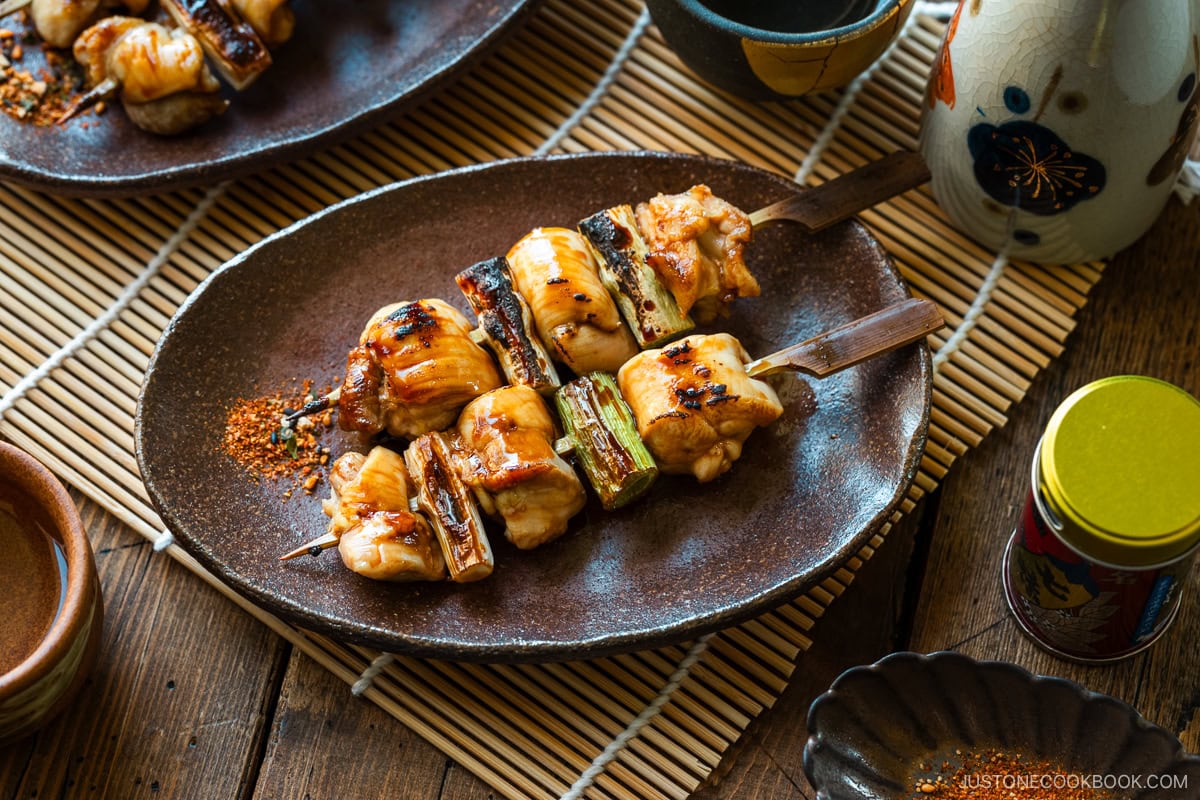
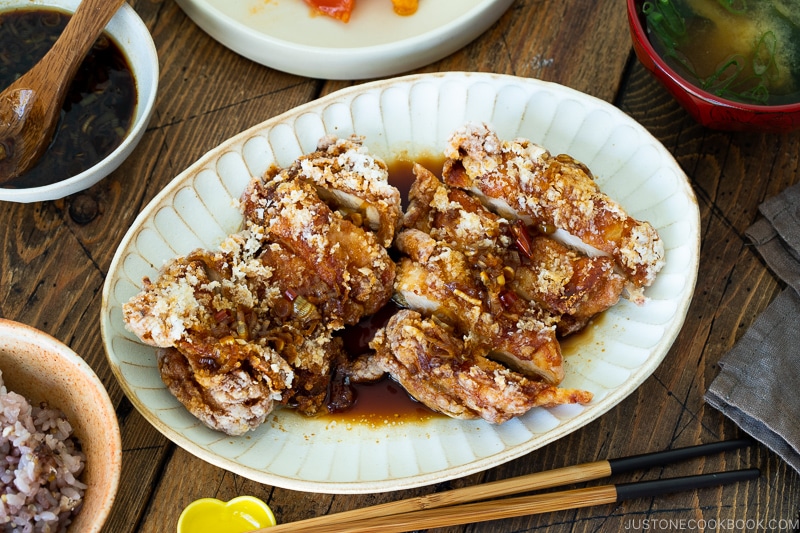
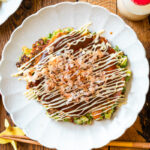
Negiyaki
Video
Ingredients
- 14 green onions/scallions (8 oz, 227 g)
- 4 oz sliced pork belly (or thinly slice meat at home; see Notes for where to buy)
- ½ cup katsuobushi (dried bonito flakes) (large flakes; use 2 packets that are 4 g each; 4 tsp powdered after grinding)
- ½ cup all-purpose flour (plain flour)
- ½ tsp baking powder
- 4 Tbsp tenkasu/agedama (tempura scraps) (you can make homemade tenkasu)
- 2 large eggs (50 g each w/o shell)
- ½ tsp soy sauce
- ⅓ cup water
- neutral oil (for frying)
- toppings of your choice (brush with soy sauce or okonomi sauce, drizzle with Japanese mayonnaise, and/or sprinkle with more katsuobushi)
Instructions
- Gather all the ingredients. One batch of this recipe makes two negiyaki pancakes. To make more, you can double or triple the ingredients (tap the 2x or 3x button to scale up), but you can only mix one batch of batter at a time. If you mix more than that, any batter left in the bowl will go flat and your pancake will not be fluffy. Mix only what you can cook right away. For one batch, use two frying pans (or a large griddle) and cook both pancakes at the same time. If you only have one frying pan, mix half a batch and cook one pancake at a time.
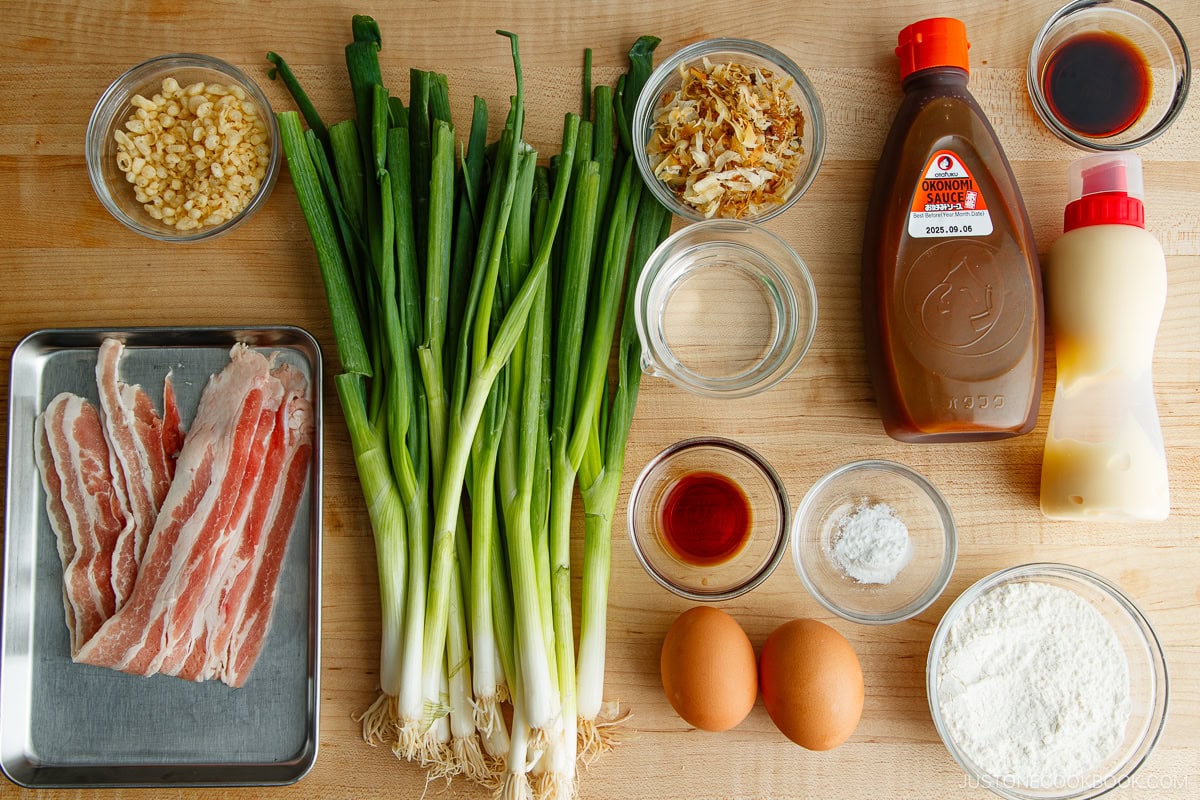
To Prepare the Ingredients
- Here‘s how to prepare the ingredients for one batch of two pancakes. First, discard the ends of 14 green onions/scallions. Then, thinly slice the green onions crosswise into rounds.
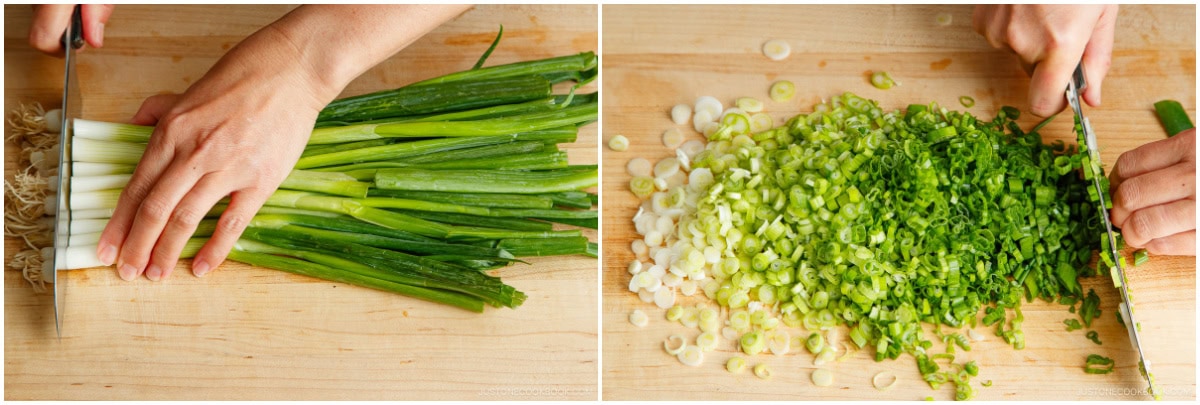
- Cut 4 oz sliced pork belly into strips 5 inches (13 cm) long. I used kitchen shears. I also cut off the fatty ends.
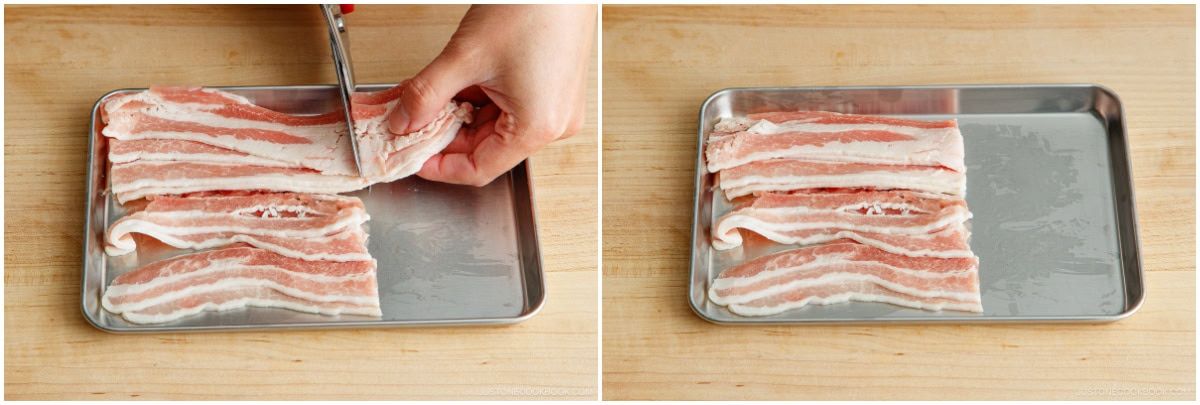
- Grind ½ cup katsuobushi (dried bonito flakes) into a powder using a mortar and pestle. You should have 4 tsp katsuobushi powder; set aside half for the batter and half for cooking the pancakes.
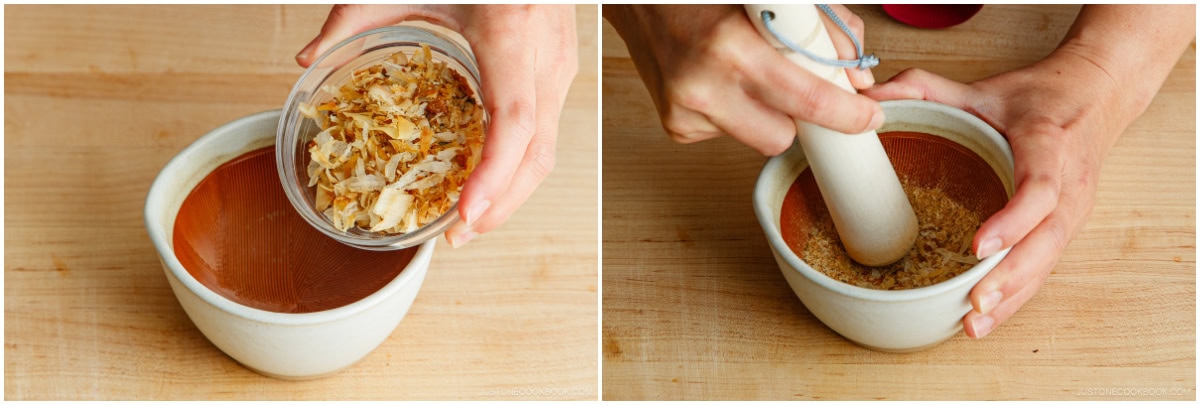
To Mix the Batter (one batch at a time)
- Now, I will show you how to mix one batch of batter. First, put the chopped green onions in a large bowl. Then, add ½ cup all-purpose flour (plain flour). Toss with a spoon to coat the green onions in the flour. DO NOT overmix. It‘s OK to leave some flour at the bottom of the bowl. Tip: Mix only one batch of batter at a time, even if you are making two or three batches.
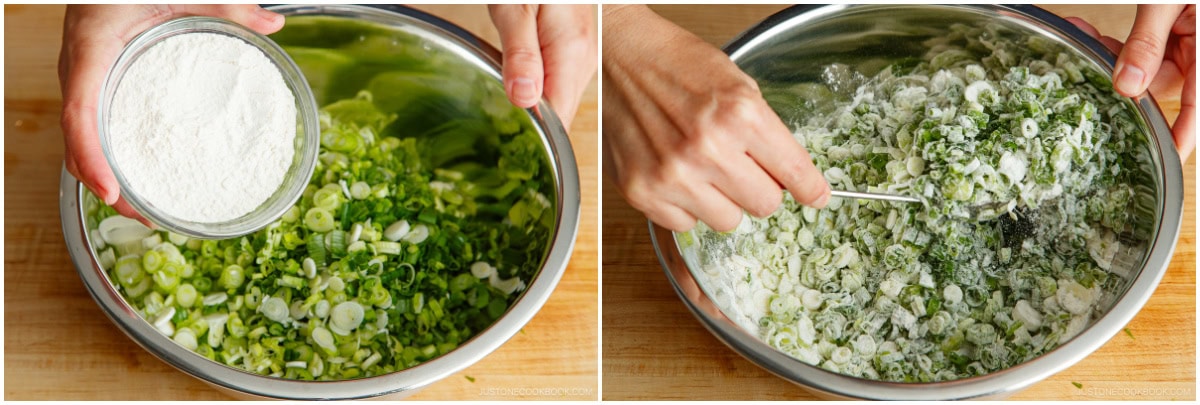
- To the bowl, add ½ tsp baking powder, 4 Tbsp tenkasu/agedama (tempura scraps), 2 tsp katsuobushi powder, 2 large eggs (50 g each w/o shell), ½ tsp soy sauce, and ⅓ cup water.
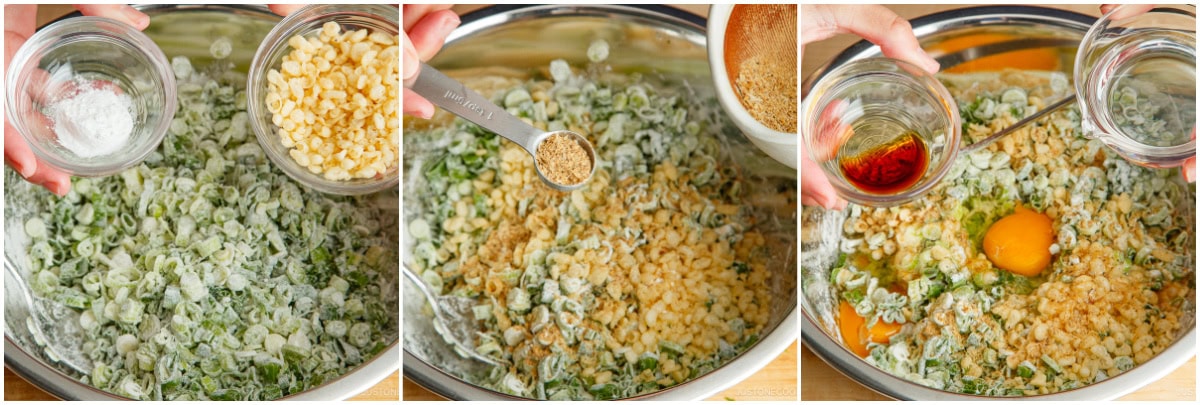
- Mix with a spoon until just combined. DO NOT overmix. Use the spoon to divide the batter in half in the bowl (for two pancakes). Tip: For a light and fluffy negiyaki, cook the batter as soon as you mix it; do not leave any the batter in the bowl.
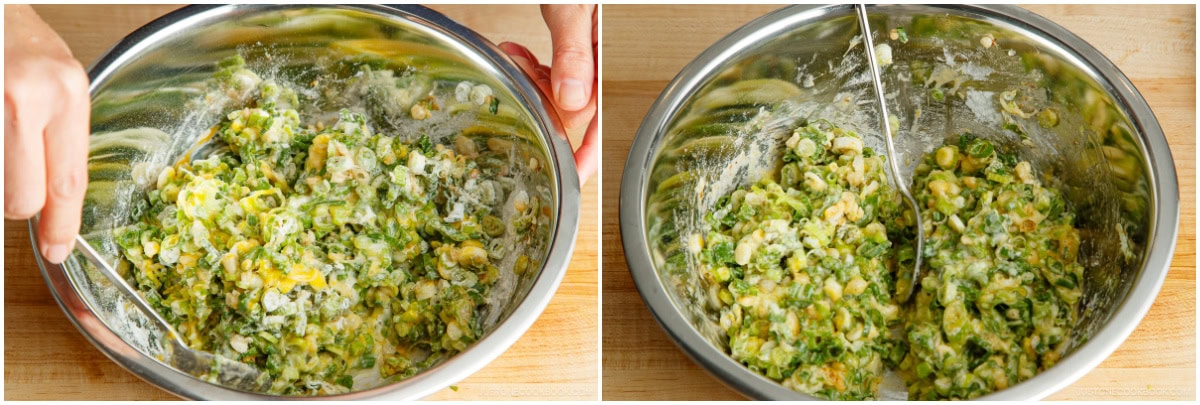
To Cook the Negiyaki
- You will cook two pancakes at once using two pans; I'll show you one pan in my step-by-step images. Heat two large frying pans or a large griddle over medium heat. When hot, add 1 Tbsp neutral oil to each pan. When the oil is hot, spoon half the batter into each pan. Spread the batter in a round shape about 5–6 inches (13–15 cm) across.
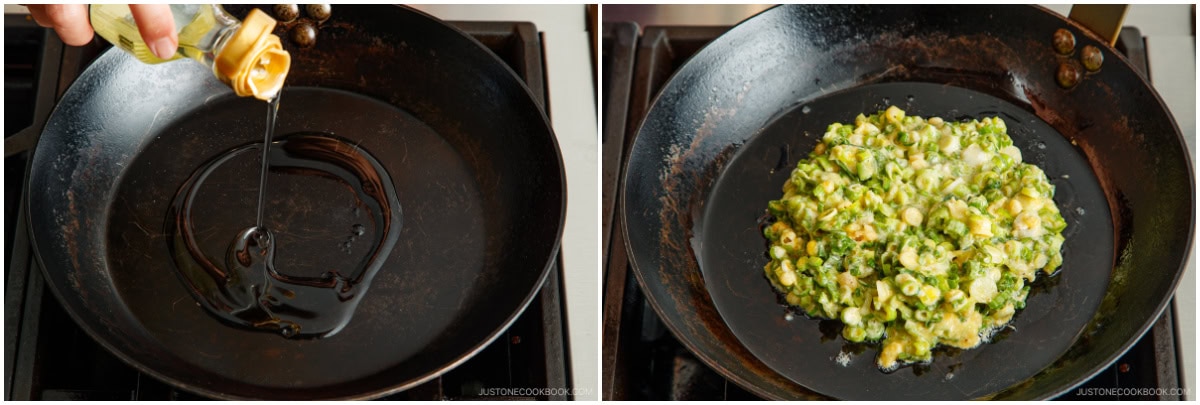
- For each pancake, sprinkle 1 tsp katsuobushi powder on top. Then, spread 4 slices of pork belly across the top of each. Cook, uncovered, on medium heat for 2 minutes.
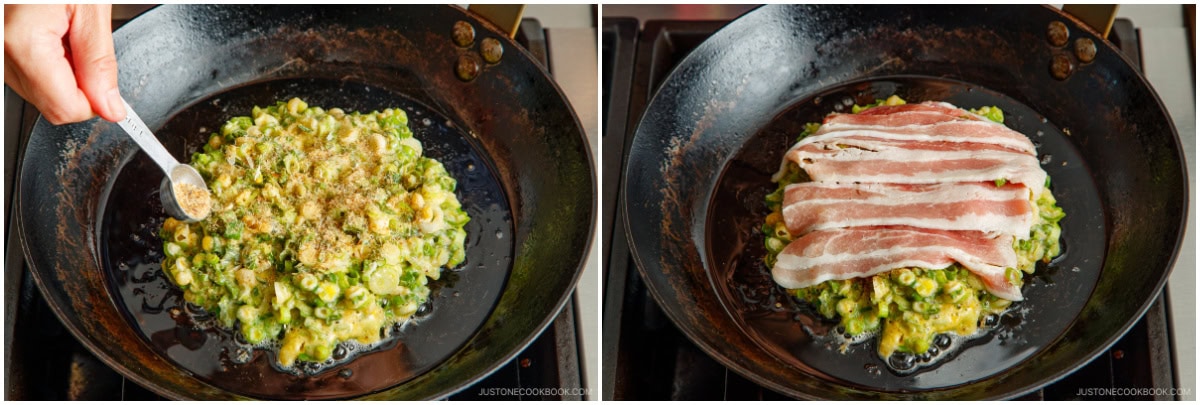
- Using two spatulas, flip the pancakes over.
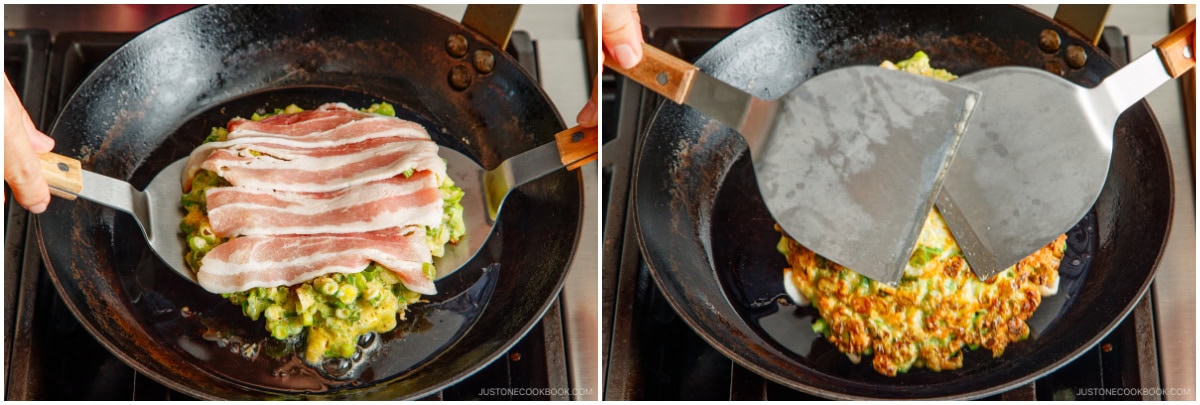
- Gently press down on the pancakes and fix the round shape, if needed. Reduce the heat to low. Cover the pans with their lids and cook for 4 minutes.
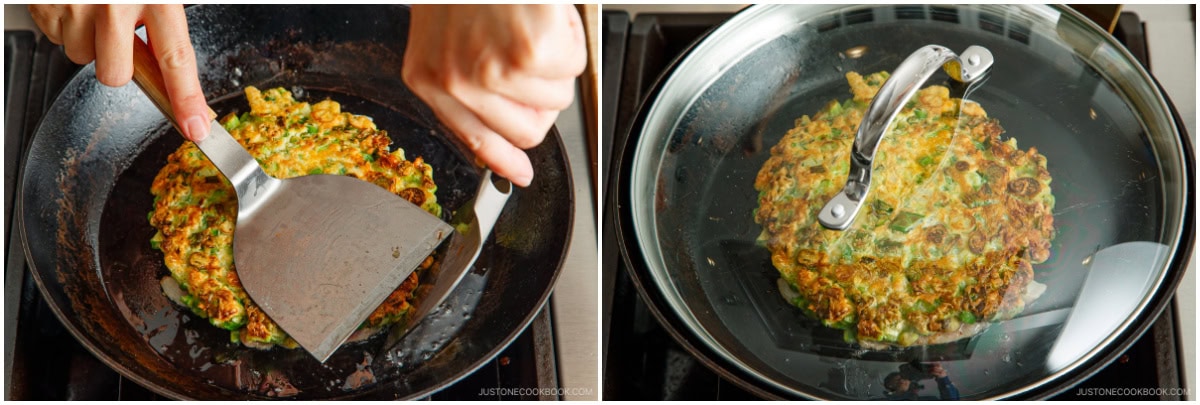
- Open the lids and flip again.
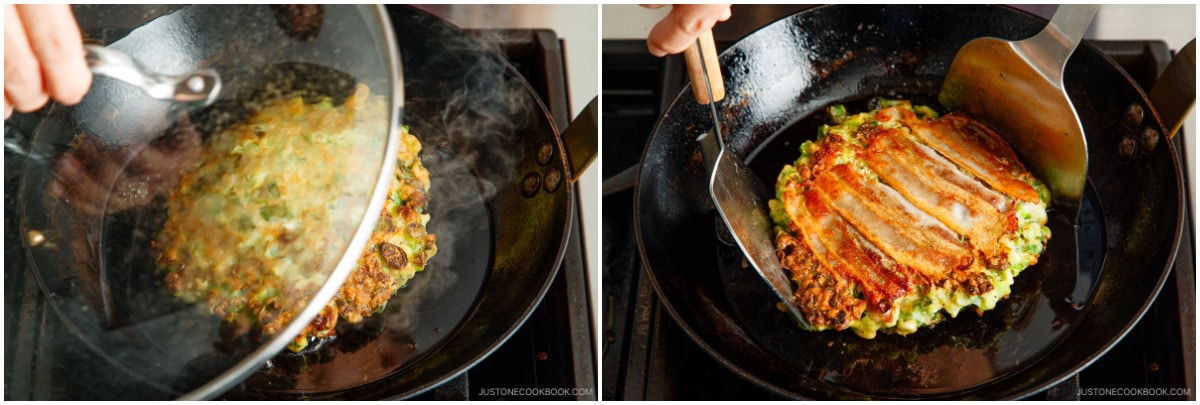
- Increase the heat to medium and cook, uncovered, for 1 minute. Transfer to individual plates. The side with the pork belly should be facing up.
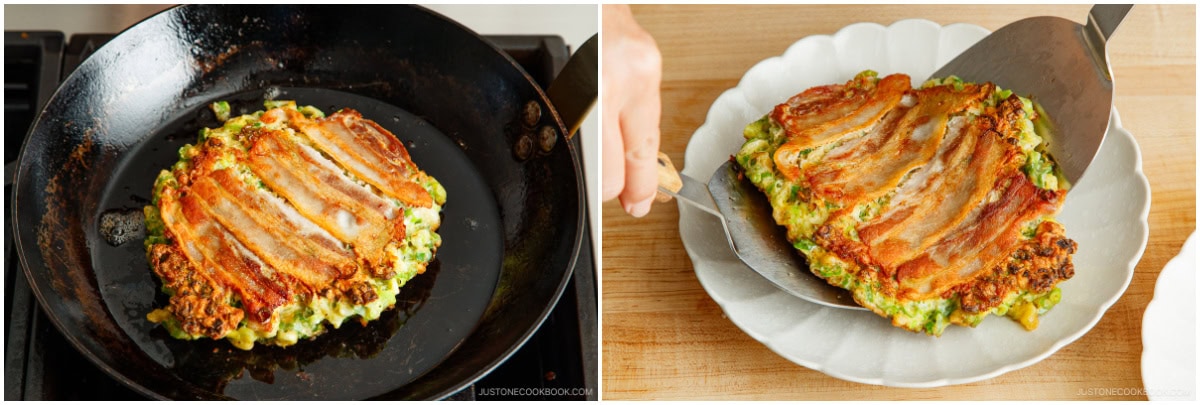
To Serve
- For a soy sauce flavor, brush the negiyaki with soy sauce and drizzle with a zigzag pattern of Japanese Kewpie mayonnaise (you can make my homemade recipe).
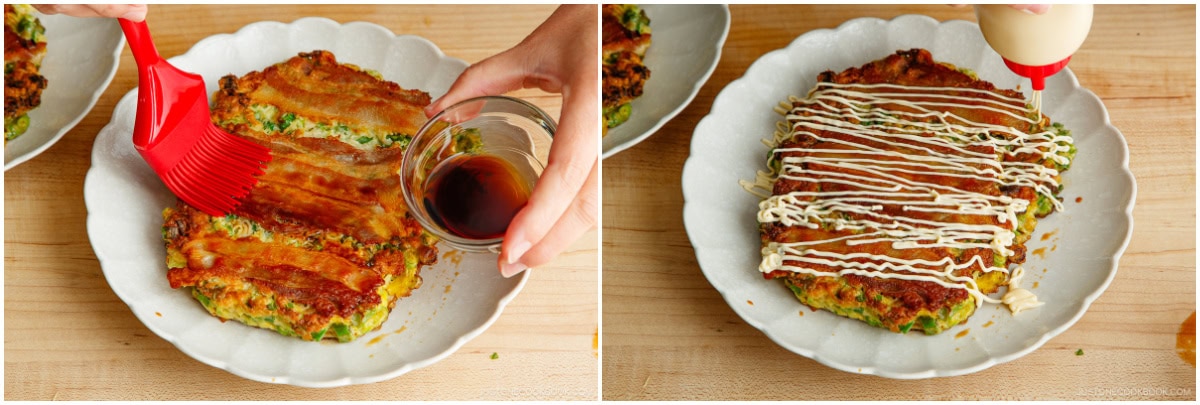
- For an okonomi sauce flavor, use a spoon to spread okonomi sauce (you can make my quick homemade version) on the negiyaki and drizzle with a zigzag pattern of Japanese mayonnaise.
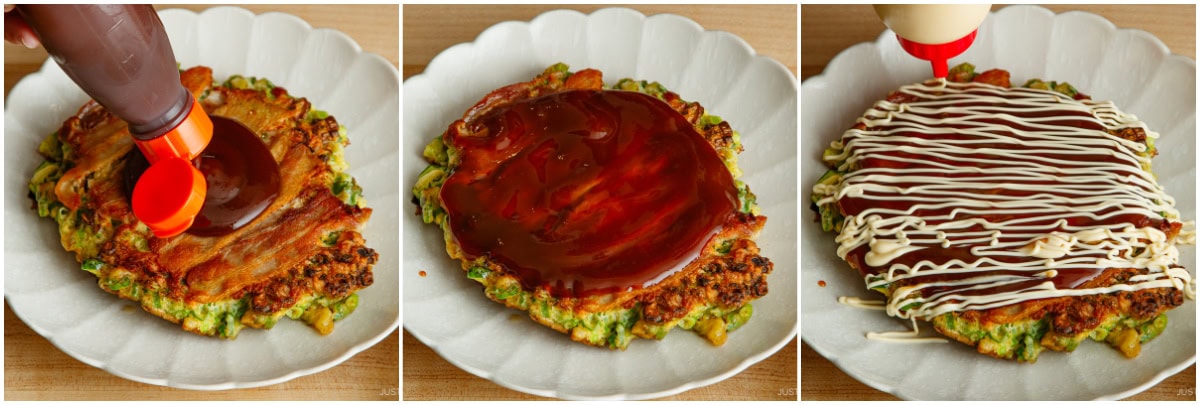
To Store
- Wrap each leftover negiyaki, without the sauce or toppings, in aluminum foil and place in a freezer bag. Store in the refrigerator for up to 3 days and in the freezer for a month. To reheat from the refrigerator, heat it in a toaster oven or oven at 350°F (180°C) for 10–15 minutes. To enjoy negiyaki from the freezer, move it to the refrigerator to defrost overnight and reheat as above, or heat direct from frozen in a 350°F (180°C) oven for 25–30 minutes.
Notes
Nutrition
Editor’s Note: This post was originally published on June 17, 2024. It was republished on October 25, 2024, with more helpful information and a new video.

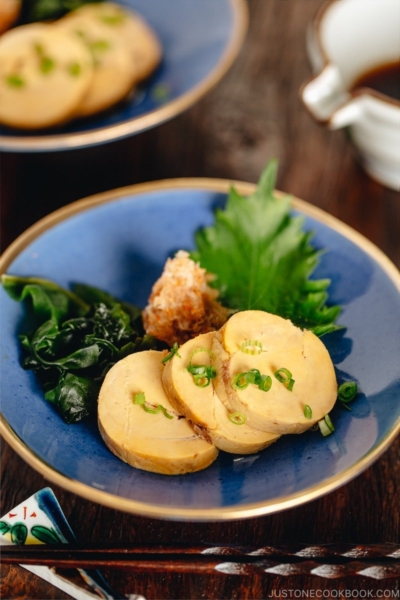
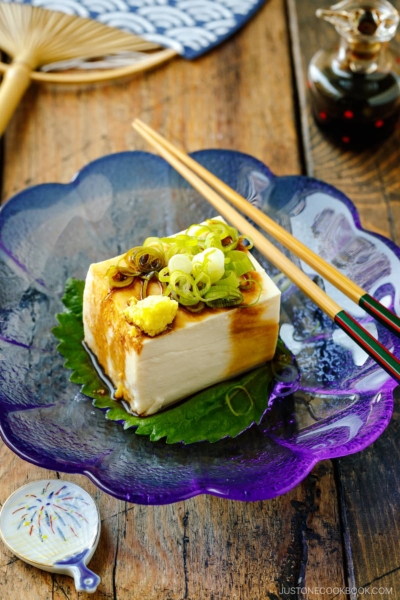
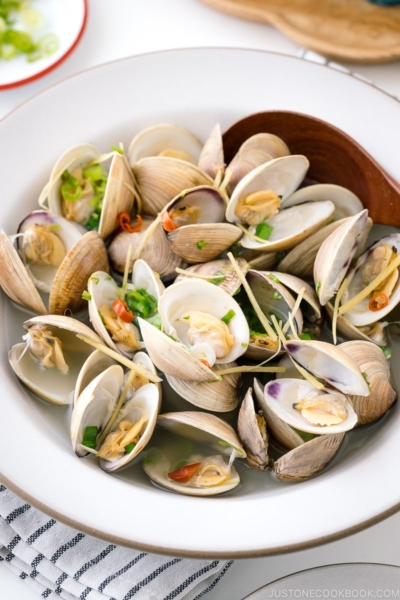
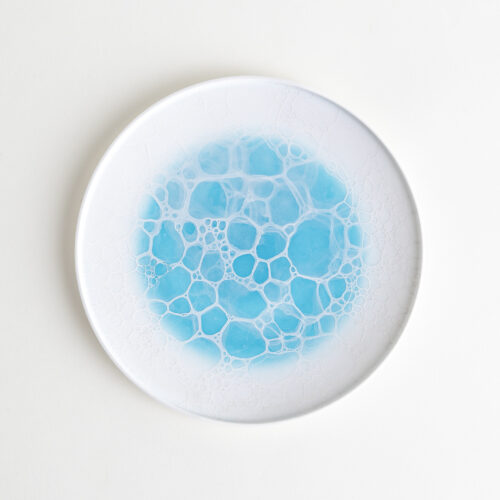
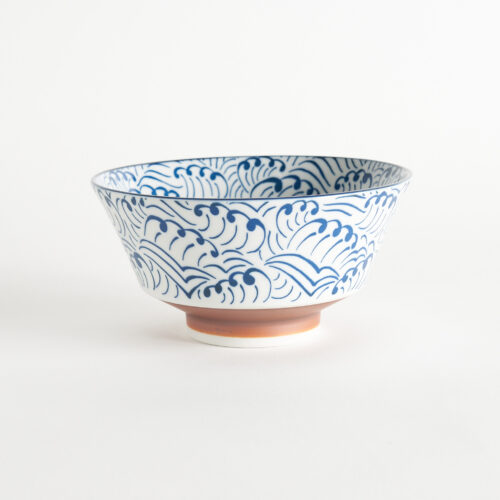
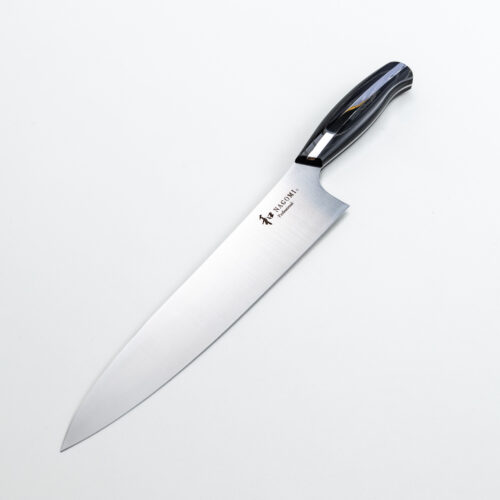
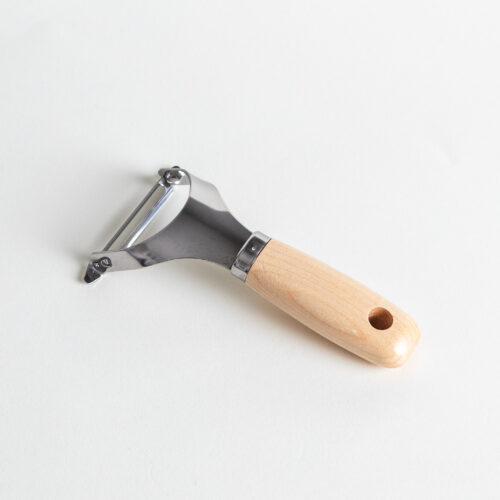
My husband and I enjoyed this for breakfast today. Oishii, desu ne
Hello Cheryl! Aww. We are glad to hear you and your husband enjoyed this dish! Ureshii desu!🥰
Thank you for trying Nami’s recipe and for your kind feedback. Happy Cooking!
Went to Japan a few weeks ago and was missing the food, so we made this as a part of our dinner tonight! It was incredibly delicious!
Hi there! We are glad to hear you enjoyed the dish! Thank you for trying Nami’s recipe and for your kind feedback!
Ohhh my Goshhh I made it today and Wow!! Delicious, savory, amazing !! My kids loved it!! Thanks for the recipe!!
Hi Lorraine! Thanks for trying this recipe! I’m so happy to hear you and your children enjoyed this recipe. Thank you for your kind feedback. 🙂
Great recipe with an amazing flavor!
Green onion is one of my favorite things, so when I saw this recipe I knew I had to try it! I didn’t have any pork belly or tenkasu on hand so I omitted them and think it still turned out great. I made the homemade okonomiyaki sauce and it was good, though next time I think I will try the soy sauce version because I enjoy the pure green onion flavor. My wife liked it with chili oil.
I’m also looking forward to trying it with Japanese negi. There’s a Japanese grocer downtown that stocks them, so I’ll have to give that a go.
I think next time I will also try using dashi instead of water for extra umami. I’ve been making Maangchi’s cabbage pancakes for awhile, which includes dashi as the liquid for the batter, and it always turns out great. I usually have dashi on hand anyway.
Also, I tried using a mortar and pestle for the katsuo (large granite one such as used in southeast asian cooking) and it wasn’t really working so I transferred it to a food processor.
Please make more recipes starring green onion!! Thank you for the great recipes.
Hello, John. Thank you for your feedback on Nami’s recipe and for sharing your experience with us.
We’re glad to hear you enjoyed the Negi flavor!
We hope your next attempt is even more amazing with your twist.😊 Happy cooking!
I love your recipes! Is there anyway for this one in particular to get The amount of carbohydrates? I’m diabetic and need to be very careful and would love to make this! Also, could I use chopped pork rinds for the tempura bits otherwise I don’t know where I would find tempura bits. Thank you so much for offering these wonderful recipes!!
Hi there! Thank you for trying Nami’s recipe. We are so happy to hear you love her recipes!
The nutritional information is included at the end of the recipe card. However, this is an approximation, so please use it as an estimate.
Nami’s homemade Tenkasu recipe is included below. https://www.justonecookbook.com/tenkasu-agedama/
It’s simple crunchy bites prepared from tempura batter. So chopped pork rinds may offer more taste, but they could be an excellent addition! We hope this helps!